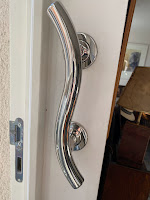 |
| Also known as 'Granny graffiti' |
 |
| Angel Hill, Bury St Edmunds |
In my first Bury blog, I included an amusing photograph of a knitted/crocheted cap on the pillar box on the far side of Angel Hill and concluded that there was at least one local eccentric with a wry sense of humour. It felt like a delightful welcome to Bury at the time. However, I am now wiser. I discover from reading a copy of The [Impeccable] Times on Easter Saturday, [my newspaper buying is restricted to one a week normally, in the interests of getting other things done.] that, under the heading, “Kniffiti gangs giving street art a new twist” an article described, ‘ a new generation of guerrilla knitters’ sweeping Britain, “yarnbombing” lampposts, letter boxes and fences. Apparently, the youngsters in Generation Z [aged 15-24] are behind the trend and I had naively imagined slightly batty O.A.Ps with time on their hands. Between 2019 and 2021 there was a 53% rise in the uptake of sewing and knitting among girls aged 15-24
 |
| Serious yarnbombing in Mexico. |
according to the data analyst, Kantar. The arts and crafts website, Hobbycraft shows that enquiries about ‘knitting wool’ have risen 178% over the last two months and in the meantime, on the sidelines, my growing suspicion that I am totally out of touch with modern life is strengthened!
This latest craze is called Kniffiti, where a person knits or crochets something and attaches it to an item of public property. One can work out where the verb, ‘yarnbombing’ comes from and the Times article describes one young student who already crochets colourful blankets to add appeal to the outside area of the pub where she works, who is intending to venture further afield and yarnbomb all over the country. This sounds like a serious movement with very cheerful effects. I like it and do wonder if there is a Bury Yarnbombers similar to the already publicised Hertfordshire
 |
| 5000 woollen poppies at St Mary's, Walsham-le-Willows. Remembrance Sunday 2021. |
Yarnbombers, already in existence? I am quietly impressed that I am acquiring modern descriptive terms such as yarnbombing even if I am unsure as to when I may be able to show off my mod vocabulary. But I do intend also to keep my ear to the ground in case I get an echo of the identity of the local Kniffiti Gang. I don’t want to join; just to admire and encourage.
And meanwhile, I continue to stroll or even quicken my pace occasionally, on early morning sallies to the Abbey Gardens to enjoy the tranquillity; the pleasing aesthetics of the floral planting; the constancy of the Abbey ruins which both beautify and sadden; the blessed emptiness of the huge green timeless space, an almost deserted natural theatre occupied by extraordinarily bold pigeons and numerous grey squirrels with the grace and speed of miniature furry arrows! I usually try to walk past those few wonderful houses in the West Front at right angles to the Cathedral, built into the stony ruins
 |
| Abbey Gardens tapestry of planting, earlier this week. |
I have also discovered the Hunter Gallery almost opposite the Angel Hotel and through the window display and a visit, thus discovered the stunning art of Edward Nooit. There is a handsome urban study of light and shadow of his in the window, priced, alas, at a little below £6,000 which at present [she writes unrealistically] is beyond a slender purse almost buckling under the weight of plumbing, electrical works, decorating indulged in since arrival in Bury. Plus of course the not inconsiderate costs of attending, suitably attired, two family weddings in May and September. Both much anticipated, of course, and for both of which I now have suitable, not to say, splendid attire!!
 |
| An earlier Edward Noott. Masterly use of light and shadows. |
 |
| Knitted caps for cobblestones. Handsome!! Does Brugge know about this trend? |


























